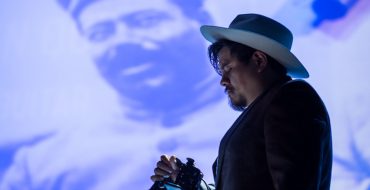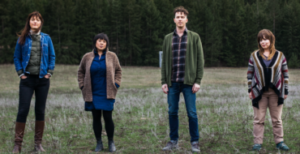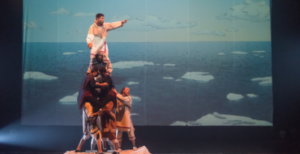Legend has it that these were the last words of Pancho Villa, a famous bandit and revolutionary general of the Mexican Revolution, (roughly 1910-1920). Shot down in the streets of Parral in the years following the end of that bloody civil war, Pancho died as he had lived his life: violently, in public, and without explaining himself.
Pancho Villa from a Safe Distance—a bilingual opera—takes on the legend and the man. “His larger than life figure, a mix of truth and myth, was the most operatic we could ask for,” composer Graham Reynolds has said.
At this year’s PuSH International Performing Arts Festival, Pancho Villa rode again. His story is told through a collage of historical texts, pictures, and vantage points, both Mexican and American. The life and legend of Pancho Villa is complicated and compelling. In one memorable refrain, the war is described as “revolución extraña”, that strange revolution in that país extraño, Mexico. This opera makes no attempt to simplify the man or the war, instead giving us numerous perspectives that layer history into legend.
Austin-based composer Graham Reynolds and librettists Lagartijas Tiradas al Sol of Mexico City came together to create this work, which is fitting as Pancho himself roamed peripatetically across the Rio Grande. The talent of these musicians is extraordinary. Six musicians (playing keyboards, drums, violin, cello, electric guitar and bass/tuba) are accompanied by mezzo-soprano Liz Cass and tenor Paul Sanchez. Together, these artists evoke a figure that was many things: folk hero, steel-hearted general, a force unleashed.
Before he took on the name of Pancho Villa, Doroteo Arango was just another peasant, indentured to work the land of a Haciendado (a wealthy landowner) along with the rest of his family. When his father died, Doroteo became the head of his family. The legend begins when a sixteen-year-old Doroteo kills the landowner, after he finds the Haciendado assaulting his younger sister. He then steals a horse, escapes to the mountains, and renames himself “Pancho Villa”.
When the revolution broke out against the rule of President Porfirio Díaz, Pancho was engaged by the revolutionary Francisco I. Madero. The former bandit proved to be an excellent strategist, earning the love and support of the people of Northern Mexico who had suffered for decades under the rule of the Haciendados.
This opera doesn’t provide much a history lesson. It offers some names, dates, and places, but the chronology is intentionally ill-defined. The variety of historical images and texts make it seem as if Pancho Villa emerged from the collective will of his people like some sort of demonio, invoked to enact revenge. In one sequence, photos of grim peasant woman wearing bandoliers and brandishing rifles march on screen. Everyone must fight against tyranny, and no one is better at fighting than Pancho Villa.
Only the bloodiness of a civil war could make a hero of a man like Pancho. In one sequence he snarls, “I do not sleep…I do not eat…But I do bite.”
This opera exalts Pancho, while displaying glimpses of his brutal character. But it glosses over the man’s war crimes, the rape and slaughter of civilians. Pancho Villa from a Safe Distance doesn’t come that close. It is about the legend, the Mexican Robin Hood who defied the corrupt elite, made a fool of the army, fought for the northern peasants and made the wealthy landowners shake with fear. At a distance, flawed, brutal men can become heroes.
In the opera’s coda, the tenor Sanchez takes centre stage. Wearing a hat and vest, he speaks lovingly of the deserts of Northern Mexico, of the lizards and the sun, his homeland. “Here we are all bandits. Is this the change we fought for?” He sings, looking out to the audience. “Doroteo no soy. Me llamo Pancho Villa!” A triumphant cry, an invocation, rousing the spirit of revolt. In the audience, we watch as we often do from our comfortable vantage point.









